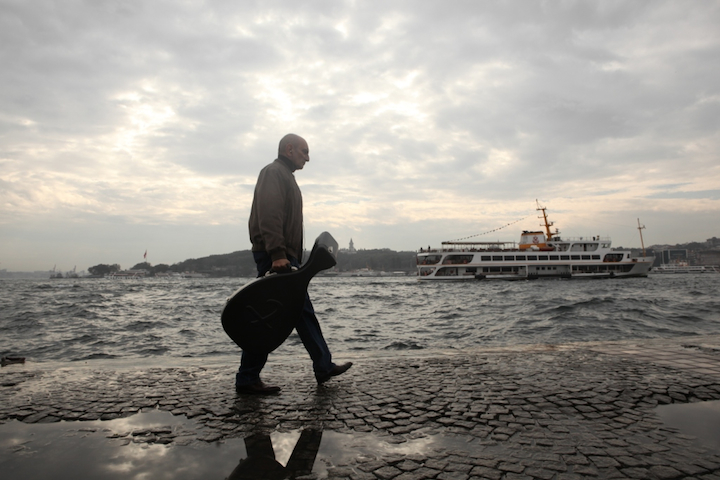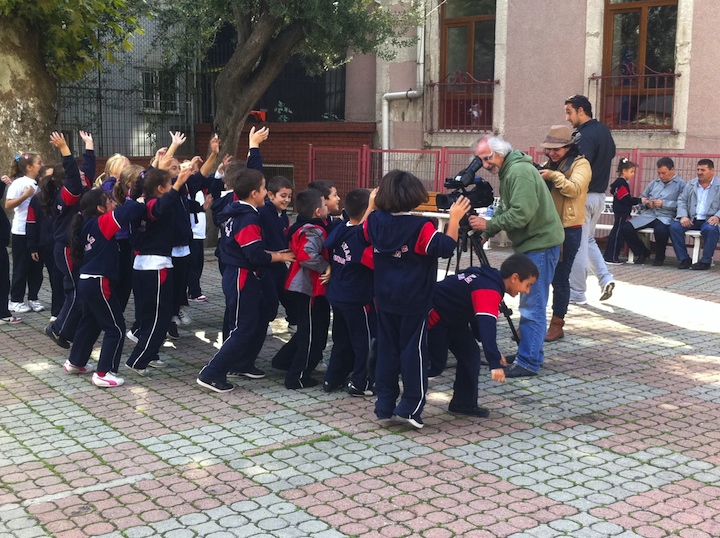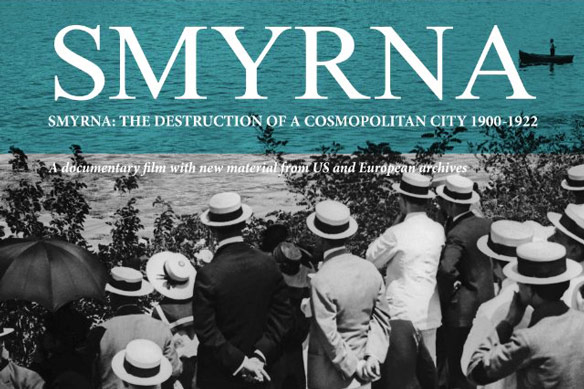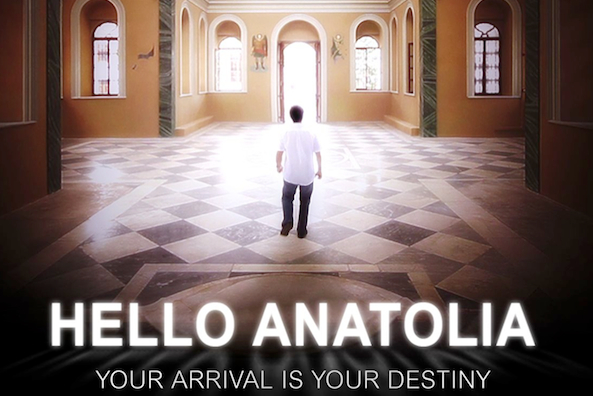[Part One of this article can be found here.]
Constantinople in Diasporan Armenian Films
While artistic production in the Armenian diaspora has been nowhere near as abundant as it had been in Constantinople during the final decades of the Ottoman Empire, generations of diasporan Armenian artists—working in the Middle East, Europe, and the Americas—have been poking holes in Yessayan’s theory since the 1920s. But in recent years, diasporan Armenian filmmakers have even begun using her own symbol as proof of the invalidity of her theory. By turning modern-day Istanbul into the object of artistic inquiry, diasporan Armenian filmmakers are disturbing the clear-cut quality of her theory by drawing inspiration for their films from the city, despite living and working in the diaspora. The exile that Yessayan sees in Emma’s works produced outside of Constantinople is still, however, visible in the works of these filmmakers. Yessayan provides an explanation for the physical traces of exile in art when she writes:
We are like exiles in a strange and distant land. We are exiles in our own native city because we are deprived of the cultural environment that our people were going to create around us with its collective effort. Only fragile, loose links connect us to our native land.
Although Yessayan sees these traces of exile as an obstacle to producing art, diasporan Armenian filmmakers have transformed their exilic states into fodder for artistic expression. Naturally they have links to the city that are more emotional than physical, but this has not prevented them from taking up the links that have been preserved in the diasporan imaginary and seeking to understand the exilic mentality they have inherited by returning to the city and exploring it through film.
Both Eric Nazarian’s 2010 short film Bolis (Armenian shorthand for Constantinople/Istanbul) and Nigol Bezjian’s 2011 documentary I Left My Shoes in Istanbul represent returns to the city that are full of symbolic value for the filmmakers, as well as for the subjects of their films.

[Still image from Eric Nazarian’s film Bolis.]
Bolis tells the story of Armenag Mouradian, a diasporan Armenian oudist from the United States who travels to Istanbul to perform at a music festival. He is the first member of his family to return to the city since they fled in 1915. These dark memories loom large as he begins to explore the Istanbul of 2010. Before his performance, he sets out to find the site of the music shop that his grandfather had owned in Ottoman times. In the process, the ambivalence he had felt towards the city lessens as he experiences modern Istanbul for himself. Myrna Douzjian succinctly explains this transformation when she writes that “[Mouradian’s] initial readiness to reject Istanbul quickly evolves into a complex set of nuanced emotions: an appreciation of the people and the city’s cultural history and a sense of nostalgia for its various spaces.”
Nigol Bezjian’s I Left My Shoes in Istanbul explores similar themes of return and nostalgia, but through the medium of the documentary. His film centers around Sako Arian, a Lebanese-Armenian poet who returns to his ancestral city and attempts to reconstruct a pre-1915 past by visiting the streets, churches, and schools that had once been a part of bustling Armenian neighborhoods. Like Mouradian, Arian has mixed feelings about returning to a city for which he feels both nostalgia and unease, but he ultimately finds comfort and familiarity in the modern incarnation of the city.
The topics treated in these films stretch beyond the purely cinematic into the lives of the filmmakers, who are both diasporan Armenians grappling with their own complicated relationships to the city. In an interview, Bezjian says that it was an unexpected sense of familiarity on his first visit to the city that motivated him to investigate it further in his film:
I didn’t set out to make a film about Istanbul. It happened through another film I was making about Taniel Varoujan [an Ottoman Armenian poet]. It was because of that film that I went to Istanbul for the first time in my life. [In Istanbul], I reflected more deeply on the city, which was familiar to me even though I never been there before. I knew the names of the neighborhoods. I knew the people. The faces of the Armenian community in Istanbul were familiar to me. I saw the Parish Councilman’s Wife; I saw Apisoghom Agha [both characters in Ottoman Armenian literature]—of course not as they were in those days, but in their modern forms. I had a Turkish assistant who was very surprised that I knew all of this on my first visit to Istanbul. So during those two or three days, I felt a lot of things, and from that experience emerged I Left My Shoes in Istanbul.

[Still image from Nigol Bezjian’s film I Left My Shoes in Istanbul.]
Eric Nazarian echoes this strange feeling of belonging and difference in describing his own experience of coming to Istanbul to make his film:
There are certain streets in Istanbul that inspired an extremely uncanny sense of déjà-vu. I still don’t know how to describe this feeling. It felt as if I was coming home, yet I knew I was still a stranger in this city. It was a very bizarre but also very poetic state of mind to be drifting in. I realized in this state that not genocide, not persecution, not politics can ever dilute or diminish the extraordinary contributions of the Armenian people to the architecture, culture, history, heritage, music, and society of Istanbul.
In their work, both filmmakers highlight the contributions Armenians have made to the city, not just for an Armenian audience anxious to see its history on screen, but particularly for a non-Armenian audience unaware of the historic link between Constantinople and the Armenian people. Particular consideration was paid to Turkish audiences. By representing members of the Armenian diaspora—a group often vilified in Turkey for their outspoken calls for genocide recognition—and sensitively portraying the inner turmoil that continues to rage in them as a result of century-old trauma, these filmmakers strive to foster compassion in the Turkish public for a people they only know as a caricature.
A mutual admiration for the city shown in the films also serves as a point of commonality. These films may even show residents of modern Istanbul corners of their city—glimpses of a 1915 Constantinople frozen in time—that they never knew existed, but that are still very much alive in the minds of diasporan Armenians living thousands of miles away.
Nazarian conceives of his film as a bridge between the Armenian diaspora and Turkey, writing that:
What’s important for me as a filmmaker is to make Bolis a human story about a Turk and a diasporan Armenian discovering an emotional connection through the act of storytelling and facing our past openly and sincerely.
Nazarian’s short film was in fact part of a larger film called Do Not Forget Me Istanbul, which sought to achieve a similar goal. The project was made up of a series of short films by filmmakers representing different ethnic minorities—Armenian, Greek, Jewish, Arab, Bosnian—that had once been integral parts of the city, but that may not be known to younger generations of Istanbulites.
While work about Constantinople and the Armenian community cannot help but evoke the past to a certain extent, these films are very much oriented towards opening up discussions that may help shape the future. But these filmmakers do not see their films as part of the heavily politicized reconciliation debate among Turkey, Armenia, and the Armenian diaspora. Their work is, however, inherently political, in that these films have the power to reach everyday people, encourage critical thought, and scrape away at the nationalism that has corroded the minds of Armenians and Turks alike.
Smyrna in Diasporan Greek Films
In the Greek diasporan imaginary, Smyrna occupies a role similar to that of Constantinople for Armenians: a historically significant city boasting a large Greek community before 1922, Smyrna has remained a place of both nostalgia and trauma for diasporan Greeks whose parents and grandparents were forced to flee the city. But like diasporan Armenians, diasporan Greeks have kept the memory of their ancestral city alive in the diaspora, preserving inherited memories of a idyllic yet painful past that they have begun to represent in film.
Maria Ilioú’s 2012 documentary Smyrna: The Destruction of a Cosmopolitan City 1900-1922 takes a historical approach to understanding her ancestral city—a city that her father had fled at the age of nine. In delving into a dimension of the history of the modern city of Izmir that is often absent from the Turkish grand narrative, she unearths photographs and archival footage and conducts interviews that reconstruct the Greek community of Ottoman Smyrna before its near destruction.

[Poster for Maria Ilioú’s film Smyrna: The Destruction of a Cosmopolitan City 1900-1922.]
Although the memory of Smyrna permeated Ilioú’s childhood, she saw that few outside the diasporan Greek community were aware of the major presence of the Greeks in Smyrna before 1922. Writing Greeks into the history of the city and raising awareness about their historic connection to it thus became a major motivation to make the film.
Like Nazarian and Bezjian, Ilioú strives to break down the barriers that both Greek and Turkish nationalism have imposed on the retelling of history. In an attempt to counter efforts to revise the history of the city, Ilioú goes to great lengths to avoid perpetuating nationalist rhetoric and to present history as objectively as possible. About her documentary, she says:
The film is very much about acceptance of Otherness—how important it is to live nearby people who come from different religions [and] cultures, [who] speak different languages, think in different ways, and despite all that, they can live very well together. And that’s what happened in Smyrna. It was a miracle somehow. [They] were happy times for at least a hundred years where this community—this multicultural community—was really thriving. And then of course, the wave of nationalism—the wave of history—was bigger than the relations of the people and all this fell apart. And that was a tragedy.
Chrysovalantis Stamelos’s 2012 documentary Hello Anatolia takes a lighter, more contemporary approach to exploring the Greek presence in Smyrna. His film documents his own process of moving from the United States to Izmir, adapting to the modern city while exploring the traces of the historic one he knew vicariously.
Like Ilioú, Stamelos grew up with family stories about Smyrna. For him, these stories were so compelling that they prompted him to return and experience the city for himself. He describes his film as “the journey of going back to the land of [his] great-grandparents, trying to discover their past through language, architecture, faith, and culture.” Like the diasporan Armenian filmmakers, Stamelos was the first member of his family to return since the trauma that prompted them to leave. Despite nearly a century, the draw of Smyrna and its firm position in the diasporan Greek imaginary has remained strong.
The memories preserved in this imaginary in fact shaped Stamelos’s initial reaction to the city. Sharing the unexpected sense of belonging that Nazarian and Bezjian had felt when they first arrived in Istanbul, Stamelos says:
When I came to Turkey for the first time I felt very at home. I didn’t feel like I was in a foreign country…the culture and the people, the people’s faces, and everything it was probably one of the most bizarre experiences I ever had. I never traveled to a country where I felt so similar to the people…When they ask me if I’m a foreigner, or yabancı in Turkish, I say no. My family’s from here and I feel very connected here.

[Poster for Chrysovalantis Stamelos’s film Hello Anatolia.]
Despite its historical roots, the film is also very much concerned with the future of Greek-Turkish relations. Stamelos understands his role in this future by, in his words, “building a bridge” between the Greek and Turkish peoples through the city that they share.
Constantinople and Smyrna Revisited
So much suffering, so much tragedy. Now my mind wanted only to return to the past. If it could only all be a lie, if we could only go back to our land, to our gardens, to our forests with their songbirds, sparrows and tiny owls, to our orchards with their tangerine trees and flowering cherries, to our beautiful festivals…
These are the final words of Greek novelist Dido Sotiriou’s 1962 novel Farewell Anatolia; here one of her characters is staring at the outline of Smyrna from the safety of one of the nearby Greek islands in 1922. While the Ottoman Armenian and Greek communities of Constantinople and Smyrna may no longer be on the radar of the inhabitants of the modern cities of Istanbul and Izmir, the memory of the cities in the imaginaries of these diasporan peoples is still vivid. Despite the time that has passed, generations three or four times removed living all over the world still carry the nostalgia and bear the trauma that these cities represent.
In examining their relationships with their ancestral cities, these diasporan artists allow the outside world a glimpse into the tormented psyches of their peoples. To diasporan Armenians and Greeks, Constantinople and Smyrna have come to signify overwhelming loss—loss of life, loss of potential, loss of a future that could have been. The loss is compounded by attempts to untwine the history of their communities from those of the cities. These books and films are attempts at resisting this dispossession of history by laying their pasts bare and enabling those willing understand to feel the psychological toll that history continues to take on the diasporan Armenian and Greek communities. The wound is still fresh.
But these works have also given diasporan Greeks and Armenians agency over their relationships with ancestral cities that beforehand they had only known through inherited memories. In the process, they have demythologized these cities, shook themselves loose of the nationalist rhetoric that dominates in the diaspora, and have come to know the cities more intimately. In these works, the inherited melancholia and nostalgia that has defined diasporan relationships with Constantinople and Smyrna make room for a new sensation, colored by more diverse experiences that combine to form a more nuanced impression of the cities, past and present.
Trauma should not overshadow the various roles these cities once had for Ottoman Greeks and Armenians, or influence the possible roles they can play now and in the future. The possibilities can only increase thanks to projects like these; as they receive more attention, they have the potential to humanize these peoples, to dispel nationalistic perceptions of them, and to encourage today’s Greeks and Armenians in the diaspora to experience their ancestral cities for themselves.
These artistic representations are not constructing a common history that attempts to suppress the suffering endured by Ottoman Greeks and Armenians, to silence them, or to squeeze them into a stale conversation about multiculturalism. These projects are, at their core, personal—constructive manifestations of an inherited exile, told through a return to the site of trauma, as a way to show Constantinople and Smyrna that they have never been forgotten.